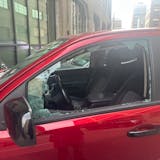Hopkins is trying to get a handle on where summer heat is worst in the city and is eyeing fixes to protect residents' health.
Apartments and condo buildings are springing up along the planned Green Line light-rail extension and nearby thoroughfares including Blake Road and Excelsior Boulevard. City officials worry the people who live in these fast-growing areas will have to deal with a preponderance of pavement and buildings that will radiate heat, making increasingly hot summers harder to bear.
"Vulnerable populations live in very hot places," Mayor Patrick Hanlon said.
Many older residents and low-income people who may have trouble affording air conditioning live in the parts of Hopkins with the least shade, fewest parks and the most pavement. The Green Line construction means it will be nearly impossible to plant trees for years, Hopkins officials noted, even as the city advocates for more housing near the light rail.
"We're only going to see more people in this corridor that's going to get even more hot," said PeggySue Imihy Bean, who works on sustainability projects for the city. "It's only going to get more dense."
Hopkins used a state grant of nearly $50,000 to study climate vulnerability along Excelsior Boulevard and Blake Road, and this week the city rolled out a "heat vulnerability" mapping tool. The online resource is meant to help community members understand variations in heat across Hopkins and give the city a clearer way to target tree-planting and other anti-heat measures.
"The next steps are going to be, what can we do as a city to help reduce the impact of climate change?" Hanlon said.
Trees are among the most effective and least-expensive solutions to mitigate extreme heat, Imihy Bean told the City Council on Tuesday.


